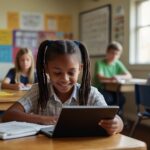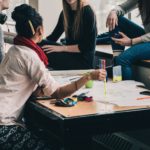A BIG List of Instructional Strategies for Teachers
Instructional Strategies for Engaging Students and Promoting Effective Learning
As educators, we’re always seeking new ways to engage our students, meet their diverse needs, and make learning meaningful. The key to effective teaching isn’t just about what we teach but how we teach it. Over time, we’ve learned that there is no one-size-fits-all approach—each classroom is unique, and every student brings a different set of strengths and challenges. In this ever-changing landscape of education, having a toolbox of diverse instructional strategies is essential for teachers striving to meet the needs of all learners.
In this post, I’ve compiled a comprehensive collection of instructional strategies for teachers that can help you create dynamic, inclusive, and impactful learning experiences. Whether you’re a new teacher looking for fresh ideas or an experienced educator searching for new approaches to teaching, this guide is designed to provide you with actionable strategies to elevate your teaching. From differentiated instruction to collaborative learning strategies and beyond, these techniques can be adapted to fit any grade level and subject area.
Let’s explore how these instructional strategies can transform the way we teach—and the way our students learn.
What Are Instructional Strategies and How Can You Use Them?
As educators, we all know that effective student learning relies heavily on well-planned, engaging lessons. While there are many teaching methods to choose from, instructional strategies are an essential aspect of lesson planning that can help create a positive and effective learning environment. These strategies aren’t just techniques—they are the ways we present information, guide our students’ learning, and ensure they understand the material.
Instructional strategies for teachers are used in combination with various teaching methods, such as direct instruction or inquiry-based learning, to enhance student engagement and comprehension. The goal of these strategies is simple: to engage students actively in their learning process and make them more likely to retain information.
Engaging Students in the Learning Process
One of the primary goals of any instructional strategy is to get students actively involved in their learning. When students engage with the material rather than passively receive it, they develop a deeper understanding and are more likely to retain new information. Collaborative learning, for instance, encourages students to work together in small groups, developing teamwork, communication, and problem-solving skills. This approach can be incredibly effective in promoting critical thinking and deeper understanding.
Similarly, inquiry-based learning shifts the focus from the teacher to the student by encouraging them to ask questions, explore new ideas, and discover knowledge on their own. This student-driven approach fosters curiosity, helping them develop a critical mindset. Differentiated instruction also plays a crucial role in ensuring that every student’s needs are met. It involves adapting your teaching methods to accommodate the wide range of abilities and learning styles in your classroom, making learning more accessible and inclusive for all learners.
Promoting Critical Thinking and Problem-Solving Skills
Another key component of successful instructional strategies for teachers is the development of critical thinking and problem-solving skills. These skills are fundamental to success both in the classroom and in life. A few strategies can effectively promote these abilities.
Socratic seminars, for example, provide students with an opportunity to engage in guided discussions around a central question or topic. By asking open-ended questions and encouraging students to consider multiple perspectives, teachers can guide students in developing their critical thinking skills. Similarly, case studies present real-world problems, asking students to analyze, interpret, and come up with potential solutions. These strategies create a dynamic learning environment where students think critically about complex issues, which enhances both their analytical abilities and their problem-solving skills.
Integrating Technology into Instructional Strategies
In today’s digital age, technology has become a powerful tool in enhancing student engagement and learning. By incorporating online simulations, educational games, and virtual field trips, teachers can make the learning process more interactive and exciting. These tools not only capture students’ attention but also allow them to explore concepts in a more hands-on way. Tools like Google Docs or collaborative platforms like Skype can also foster teamwork and communication, even when students are physically apart.
When technology is thoughtfully integrated into your instructional strategies, it provides new ways for students to interact with the material, collaborate with peers, and present their findings. Educational technology is no longer just an optional tool—it has become an integral part of creating an engaging and dynamic learning environment.
Hands-On, Experiential Learning
There’s something incredibly powerful about hands-on learning experiences. By actively engaging in authentic tasks, students don’t just absorb information—they apply it. This kind of learning promotes deeper understanding and helps students make connections between the classroom and the real world. From science experiments to field trips or service learning projects, experiential learning allows students to be active participants in their educational journey.
Whether it’s solving a problem, exploring a concept through an experiment, or participating in a community project, hands-on learning fosters critical thinking and problem-solving skills. It also empowers students by giving them a sense of ownership over their learning process, making experiential learning one of the most effective instructional strategies for teaching.
Collaboration and Teamwork in the Classroom
Collaboration and teamwork are essential skills for success—not only in school but also in life. By promoting group projects, pair work, and class discussions, you create opportunities for students to develop these skills. These strategies not only help students learn to work effectively with others but also enhance their communication and social skills, both crucial in today’s interconnected world.
Fostering a collaborative classroom environment helps students understand the value of different perspectives and promotes a sense of community within the class. By using collaborative learning strategies, teachers can build a culture of mutual respect and shared responsibility for learning.
Project-Based Learning: Real-World Applications
Project-based learning (PBL) is another instructional strategy that encourages students to engage with real-world problems. PBL allows students to work on long-term projects that require them to apply their knowledge and skills in creative ways. This approach not only deepens students’ understanding of the content but also encourages critical thinking, collaboration, and problem-solving. By tackling authentic problems and creating real-world solutions, students develop a sense of ownership and responsibility for their learning.
Scaffolding Techniques: Breaking Down Complex Tasks
Scaffolding is an essential technique for helping students tackle complex tasks. It involves breaking down large concepts or tasks into smaller, more manageable steps. This allows students to build on their prior knowledge and gradually develop new skills. Examples of scaffolding include providing step-by-step instructions, using graphic organizers to represent information visually, and modeling tasks for students to follow.
Graphic Organizers: Visual Tools for Enhancing Learning
Graphic organizers are powerful visual tools that help students organize and understand new concepts. These tools come in various forms, including Venn diagrams, concept maps, and flow charts. By integrating graphic organizers into your lessons, you can support student comprehension, improve retention, and create opportunities for students to connect ideas more effectively. These visual aids help students visualize relationships and connections between concepts, making complex material more accessible. They also provide a way for students to organize and synthesize information, enhancing their ability to analyze and comprehend new content. Furthermore, graphic organizers are beneficial for supporting students with learning differences by simplifying complex concepts and breaking them down into more manageable parts.
Promoting Equity and Inclusion in the Classroom
Promoting equity and inclusion in the classroom is essential for creating a positive learning environment where all students have access to success. Effective teaching strategies should aim to meet the diverse needs of students, regardless of their background or abilities. Differentiating instruction allows you to tailor your approach to each student’s learning needs, ensuring that all students can participate in meaningful ways. Additionally, incorporating diverse perspectives into lesson content helps create an inclusive curriculum, fostering a sense of belonging for all students. Supporting English language learners (ELLs) is also important, as providing additional resources or scaffolding can bridge language gaps and enhance academic progress. Culturally responsive teaching techniques enable educators to connect with students from various backgrounds, making learning more relevant and engaging for everyone.
Student Motivation and Engagement Strategies
Motivating and engaging students is a key aspect of successful learning. Instructional strategies that focus on motivation create an environment where students are actively involved in their learning. Offering students opportunities for choice and autonomy helps them feel more in control of their learning process, which in turn increases their investment in it. Hands-on, experiential learning activities provide students with interactive, real-world experiences that make learning more memorable and meaningful. Additionally, promoting student ownership of learning encourages students to set personal goals and take responsibility for their progress. Supporting self-directed learning also plays a vital role in fostering independent learners who are able to manage their own educational journeys.
Professional Development for Teachers: Growing Your Skills
As educators, ongoing professional development is essential to refining our teaching practices and staying up-to-date with the latest research and trends in education. Continuously improving your skills and learning new teaching strategies allows you to provide better educational experiences for your students. There are many opportunities for professional development, including attending conferences and workshops to learn from experts and network with colleagues. Online courses and webinars offer flexibility and a wealth of knowledge on new teaching methods and technologies. Collaborating with peers through mentorship or sharing best practices can also enhance your teaching and foster a supportive learning community. Finally, participating in professional learning communities (PLCs) allows educators to exchange ideas and receive valuable feedback from fellow teachers.
Instructional Strategies: Essential Tools for Effective Teaching
Instructional strategies are fundamental tools for effective teaching. By utilizing a variety of strategies—such as differentiated instruction, collaborative learning, and inquiry-based learning—teachers can foster student engagement, promote critical thinking, and support diverse learning needs in the classroom. It’s important to regularly reflect on instructional practices and make adjustments based on student feedback and outcomes to optimize learning. Moreover, professional development is key to continually improving instructional strategies. Staying informed about best practices enables teachers to create a positive, inclusive learning environment that supports students in achieving their full potential.
The Ultimate List of Instructional Strategies for Teachers
Now, let’s dive into the big list of instructional strategies examples. This collection has been carefully curated, and I will continue to add and update it as my time allows. I hope you find this resource helpful and maybe even a little more enjoyable than an in-service day!
Below, you’ll find a range of strategies, resources, and informative videos, along with basic pedagogical definitions. I’ve spent months gathering and organizing this content, and much of it is ready to be applied directly in your classroom. Please feel free to share this site with other educators—whether through the social buttons above or by linking to this page from your own teaching website or blog. The comments section at the bottom is a great place to share your own insights, tips, and expertise with fellow teachers from around the world. Thank you for being part of this community, and please share
Assessment & Evaluation Strategies
- 3-2-1: An activating strategy where students list three things they already know, two things they want to learn, and one question related to the topic.
- Authentic Assessment: Real-world tasks requiring students to apply their knowledge to solve problems or complete tasks.
- Benchmark Testing: Standardized assessments used to measure a student’s performance against predetermined criteria or benchmarks.
- Dynamic Assessment: An interactive, formative assessment focusing on identifying a student’s learning potential and how they can be supported.
- Exit Tickets: Short, end-of-lesson assessments used to check for student understanding.
- Entrance Tickets: Quick engagement tools used at the beginning of the lesson to assess prior knowledge or provoke thinking.
- Formative Assessments: Continuous assessments that help monitor student learning and guide instruction.
- Ipsative Assessment: Self-assessment where students compare their current performance to their own previous achievements.
- Portfolio Assessment: A collection of student work that showcases learning growth and achievement over time.
- Self-Evaluation: Reflection tool where students assess their own learning and progress.
- Summative Assessments: Final evaluations conducted at the end of a unit or course to assess cumulative learning.
Active Learning Strategies
- Active Learning: Strategies that require students to actively engage with content through discussions, problem-solving, and activities.
- Active Participation: Involves students in the learning process through various activities like projects or discussions.
- Experimental Learning: Learning by engaging directly in hands-on activities or real-world experiences.
- Four Corners: A movement-based activity where students physically move to different corners of the room to share opinions on a statement.
- Give One / Get One: An interactive activity where students share one thing they have learned and get one thing from their peers.
- Grab Bag: Randomly assigning tasks or questions to students from a “bag” to promote engagement.
- Partner Quiz: A collaborative quiz where students work in pairs to answer questions.
- Roll the Die: A fun, random selection process for assigning tasks or questions using a die.
- Snowball Fights: An active learning strategy where students write a task or question on a piece of paper, crumple it into a ball, and toss it for their peers to answer.
- Stop and Go: A structured pause in lessons where students reflect on the material before proceeding.
- Think-Pair-Share: A strategy where students first think about a question, then pair up with a partner to discuss, and finally share their thoughts with the class.
- Think-Pair-Write: An extension of Think-Pair-Share where students write their responses before sharing them.
- Think-Write-Share: Students think, write, and then share their responses with the class.
Cognitive Development Strategies
- Abstract Thinking: Encouraging students to think about concepts beyond concrete ideas.
- Bloom’s Taxonomy Activities: Activities designed to target different cognitive levels, from remembering to creating.
- Cognitive Strategy Instruction: Teaching students strategies for thinking through problems and solving them.
- Cognitive Thinking: Using mental processes such as perception, memory, and reasoning to solve problems.
- Convergent Thinking: A cognitive approach that focuses on finding one correct solution to a problem.
- Critical Thinking Activities: Exercises that promote logical analysis, reasoning, and problem-solving.
- Divergent Thinking: A strategy that encourages the generation of multiple solutions or ideas.
- Metacognition: The process of thinking about one’s thinking to monitor and improve learning.
- Schema Building: Connecting new information to existing knowledge for deeper understanding.
- Socratic Seminar: A discussion-based method where students engage with a central question using critical thinking.
- Visible Thinking Routines: Structured methods to help students organize and reflect on their thinking.
Collaborative Learning Strategies
- Collaborative Learning: Working in groups to achieve shared learning goals.
- Cooperative Learning: Structured group activities that promote collaboration and accountability.
- Discussion Groups: Small groups of students engaging in dialogue to explore and discuss topics.
- Group-Based Instruction: Collaborative learning where students work together on tasks to understand content.
- Group Work: Activities where students collaborate to complete assignments or solve problems.
- Group Writing: Collaborative writing activities that foster teamwork and improve writing skills.
- Jigsaw Activities: A cooperative strategy where students become experts in one section of content and then share their knowledge.
- Peer Discussions: Discussions between students to clarify, discuss, and deepen understanding.
- Peer Teaching: A strategy where students teach each other, reinforcing their understanding of the material.
Language & Literacy Strategies
- Academic Language Scaffolding: Supporting students’ understanding and use of academic language.
- Acrostics: Memory devices where the first letter of each word in a sequence forms a word or phrase.
- Alphabet Games: Interactive activities to help students learn and recall the alphabet.
- Balanced Literacy: An integrated approach to literacy instruction that combines reading and writing in meaningful contexts.
- Book Talks: Presentations where students share books they’ve read and discuss their thoughts.
- Choral Reading: A reading activity where the teacher and students read a passage together.
- Critical Literacy: Encouraging students to analyze texts critically and question the author’s intent and perspective.
- Critical Reading: Actively engaging with texts to interpret and evaluate the author’s purpose and meaning.
- Critical Listening: Developing the skill to listen analytically and evaluate the validity of information.
- Language Experience Approach: Using students’ personal experiences as a basis for literacy instruction.
- Letters Through Time: A strategy for studying history through reading and writing historical letters.
- Phonics: Teaching reading through the relationship between sounds and letters.
- Reading Comprehension: Teaching students to understand, interpret, and analyze written text.
- Reciprocal Teaching: A strategy where students take turns leading small reading groups, practicing summarizing, questioning, and predicting.
- Sentence Starters: Prewritten phrases to help students begin their responses or writing.
- Sheltered Instruction: Modifying content to make it accessible for language learners.
- Total Physical Response (TPR): A language teaching method that incorporates physical movement to reinforce learning.
- Writer’s Workshop: A structured time for students to work on writing, including drafting and revising.
- Writing Prompts: Statements or questions that inspire student writing.
- Writing Strategies: Techniques to help students develop and improve their writing.
Technology Integration Strategies
- Augmented Reality Learning: Using digital overlays to enhance learning experiences.
- Blended Learning Rotation: Combining online and in-person learning by rotating students between the two formats.
- Computer-Assisted Instruction: Incorporating technology to enhance learning through interactive lessons and activities.
- Digital Storytelling: Using multimedia tools to create narratives that convey lessons or personal stories.
- Distance Learning: Remote learning facilitated through online platforms and tools.
- Educational Technology: Using technological tools and resources to support and enhance classroom learning.
- Information Technology: Utilizing digital resources and tools for teaching.
- Interactive Simulations: Virtual platforms that allow students to interact with and manipulate concepts.
- Nearpod: A platform that facilitates interactive lessons with multimedia features.
- Podcasts: Audio recordings that can be used for content delivery, study aids, or reflections.
- Technology-Infused Project-Based Learning: Incorporating technology into project-based learning to enhance research and creation processes.
- Video Mini-Lessons: Short videos that focus on teaching specific concepts.
- Virtual Classrooms: Online learning spaces where students engage with teachers and classmates in real-time.
- Virtual Field Trips: Digital exploration of different locations and experiences for educational purposes.
Organizational & Visual Learning Strategies
- Activity Centers: Rotating stations where students engage with different learning activities.
- Classroom Mailboxes: Organizing materials and assignments in a way that makes them easy for students to access.
- Classroom Organization: Structuring the physical layout of the classroom to facilitate learning.
- Classroom Posters: Visual aids used to reinforce learning concepts and behaviors.
- Classroom Procedures: Clear routines and processes that help maintain a structured and efficient classroom.
- Classroom Routines: Regular activities that create predictability and structure in the classroom.
- Classroom Rules: Guidelines for student behavior to maintain a positive and productive environment.
- Flexible Seating: Offering students choice in where and how they sit during lessons.
- Frayer Model: A graphic organizer that helps students explore concepts by examining definitions, characteristics, examples, and non-examples.
- Illustrations: Visual representations to help explain concepts and ideas.
- KWL Charts: A tool to guide students in identifying what they Know, what they Want to know, and what they have Learned.
- Learning Logs: Journals where students document their learning progress.
- Math Journals: Notebooks where students write about their mathematical thinking and problem-solving processes.
- Metacognition Sheets: Tools for students to reflect on their learning and thinking processes.
- Modular Tools: Interactive learning tools that can be adapted to different tasks or concepts.
- Sticky Notes: Simple tools for students to jot down thoughts, questions, or key points during lessons.
Graphic Organizers: Visual Tools for Enhancing Learning
Graphic organizers are powerful visual tools that help students organize and understand new concepts. These tools come in many different formats, such as Venn diagrams, concept maps, and flow charts. By incorporating graphic organizers into your lessons, you can support student comprehension, enhance retention of information, and create opportunities for students to make connections between ideas. They help students visualize relationships and connections between concepts, making complex material more accessible. Furthermore, graphic organizers allow students to organize and synthesize new information, enhancing their ability to analyze and comprehend content. They are especially beneficial for students with learning differences, as they simplify complex concepts and break them down into manageable pieces.
Promoting Equity and Inclusion in the Classroom
Equity and inclusion are critical components of effective instructional practices. By fostering these values in the classroom, teachers can create a positive and inclusive learning environment that meets the diverse needs of all students. Effective instructional strategies should ensure that every student has equal access to learning, regardless of background or ability. Differentiating instruction allows teachers to meet the individual learning needs of all students, ensuring inclusivity. Integrating diverse perspectives into lesson content helps create a more inclusive curriculum that reflects the experiences of all students. Additionally, providing support for English language learners (ELL) ensures that language barriers do not hinder academic progress. Culturally responsive teaching techniques help connect with students from different cultural backgrounds, making learning more relevant and engaging.
Student Motivation and Engagement Strategies
Motivating and engaging students is essential for fostering successful learning. Instructional strategies that focus on student motivation help create an environment where students are actively invested in their learning. Offering opportunities for student choice and autonomy empowers students to take ownership of their learning journey, which increases motivation. Hands-on, experiential learning activities make learning interactive and memorable, encouraging students to apply concepts in real-world scenarios. Promoting student ownership of learning involves encouraging students to set personal goals and take responsibility for their academic progress. Self-directed learning strategies further support this by helping students become independent learners who can manage their educational paths.
Professional Development for Teachers: Growing Your Skills
Continuous professional development is key to refining your teaching practices and staying informed about the latest trends and strategies in education. Ongoing learning allows educators to improve their skills and provide a better educational experience for their students. Teachers can participate in professional development by attending conferences and workshops, where they can learn from experts and network with peers. Enrolling in online courses and webinars offers flexibility and access to new teaching strategies and educational technologies. Collaboration with colleagues through peer mentorship and sharing best practices can enhance teaching effectiveness. Professional learning communities (PLCs) provide an opportunity to exchange ideas and receive feedback from fellow educators, further enhancing your teaching.
Instructional Strategies: Essential Tools for Effective Teaching
Instructional strategies are integral to effective teaching. By using a variety of strategies such as differentiated instruction, collaborative learning, and inquiry-based learning, teachers can engage students, encourage critical thinking, and address the diverse learning needs in the classroom. Regular reflection on instructional practices is important to identify areas for improvement and ensure that strategies are meeting students’ needs. Additionally, professional development plays an important role in continually refining instructional strategies. Staying current with best practices helps teachers create a positive, inclusive learning environment, ultimately supporting students in reaching their full potential.
For our visual learners 🙂
I wanted to include an infographic about Marzano’s 9 instructional strategies for teachers. Why? Because some people think that this short list is all there is when it comes to planning instruction, and that’s what they’re looking for right now. Here’s his list, but I invite you to keep on reading it after you check it out. There is SOOO much more here, and it is all meant to help teachers and students to achieve new levels of success!

Find more education infographics on e-Learning Infographics
A Resource for Teachers
Welcome to a resource designed to be one of the best online tools for educators. As a teacher, it’s essential to be familiar with a variety of instructional strategies to keep students engaged and make learning more dynamic. These teaching strategies are the foundation of your practice, and taking the time to learn and apply them will benefit both you and your students. Furthermore, incorporating variety into your teaching methods can help prevent burnout, keeping your lessons fresh and effective.
Establishing and Breaking Routines in the Classroom
While routines are valuable in providing structure, they can sometimes lead to complacency, causing both students and teachers to lose interest. This is where a diverse set of instructional strategies comes in. By introducing new approaches to teaching, you can reignite enthusiasm in your classroom and offer students more engaging learning experiences. The list of strategies above is designed to help you break free from the monotony of routine and introduce creative and effective methods into your lessons. Feel free to refer to this list, print it out, and check off the strategies as you implement them in your teaching. As this site continues to grow, I will update and add more strategies, providing clear definitions and practical applications to make these concepts accessible for all educators.
New Ideas for Teaching
For newer teachers, especially those with less than a year of classroom experience, the world of instructional strategies may seem overwhelming. Often, you’ll encounter educational theories or frameworks introduced through in-service training or handed-down binders filled with educational jargon. These materials can sometimes be confusing or even intimidating. The goal of this site is to make these strategies more digestible and less daunting. I hope this resource will offer valuable, practical teaching strategies and methods that can help you build confidence and excel in your teaching practice.
Becoming a Better Teacher Through Reflection
Reflecting on your teaching methods is an essential part of becoming a better educator. We all have moments where we remember experiences from our own school days—those moments when a teacher’s creativity, passion, and approach to learning stood out. I strive to bring that level of engagement to my classroom by continuously reflecting on and adapting my teaching methods. While daily tasks like grading papers and preparing lessons are essential, the moments that truly resonate with students come from applying meaningful, active learning strategies. By reflecting on my teaching practices and making adjustments where necessary, I hope to keep lessons engaging and impactful.
What Are Instructional Strategies?
Instructional strategies are simply the various methods teachers use to engage students and help them learn. These approaches range from collaborative learning and differentiated instruction to inquiry-based learning and hands-on activities. Over the years, teachers have refined these techniques to ensure they meet the needs of all students. Effective teachers adapt their approach based on the specific needs of their students, tailoring lessons to maximize engagement and foster critical thinking.
Don’t Get Buried in Educational Jargon
In the field of education, the language can sometimes feel overwhelming due to the sheer volume of terms and acronyms used. Teachers are often too busy teaching and managing classrooms to keep up with the latest educational research. Many of the strategies discussed on this site are commonly known, and while they may be referred to by different names, they share similar goals of enhancing student learning and engagement. For newer teachers, this site offers a straightforward summary of popular instructional methods. The goal is to help you feel empowered to implement these strategies without feeling burdened by the technicalities.
Becoming an Effective Teacher for Your Students
To be an effective teacher, it’s essential to plan lessons that not only convey information but also connect with students on a deeper level. Effective teaching goes beyond simple knowledge delivery—it’s about creating a learning environment where students feel invested and excited to learn. By exploring and experimenting with a variety of instructional strategies, such as project-based learning, differentiated instruction, and hands-on activities, you can engage a wider range of learning styles, making the material more accessible to all students. Some students may thrive with independent study, while others may learn best through collaborative projects or visual aids. The key is finding what works best for each student and adjusting accordingly.
Practical Application and Differentiating Instruction
Practical application is essential in helping students connect what they’re learning to real-world scenarios. For example, in my math classes, I always performed better when I could understand how concepts applied beyond the classroom. Teachers must find ways to link theoretical knowledge to practical applications. This can be achieved by using varied teaching methods, such as inquiry-based learning or hands-on activities. Differentiation also plays a vital role in reaching all students, ensuring that each individual receives the support they need to succeed. Whether it’s adjusting the pace, providing additional resources, or offering different pathways to learning, differentiation ensures that each student has an opportunity to thrive.
Group Work: An Effective Teaching Strategy
Group work is an essential strategy that allows students to collaborate, communicate, and learn from one another. While not every student may be comfortable working in groups, the benefits are significant. Group projects foster teamwork, problem-solving, and creative thinking skills. For students who struggle with certain concepts, working in groups can also provide the support they need from their peers. It’s important, however, to balance group activities with independent work to cater to different learning styles.
Spiraling Previously Learned Material
Spiraling is a method that involves revisiting concepts multiple times, gradually increasing the complexity as students’ understanding deepens. This technique is particularly effective in reinforcing foundational concepts that are essential for learning more advanced material. By incorporating spiraling into your curriculum, you ensure that students don’t just memorize content but instead gain a thorough understanding that they can build upon.
Using Mnemonics to Support Memory
One of the most effective ways to help students retain information is by using mnemonics. These memory aids are simple tools that associate new information with something more familiar, making it easier to recall. For instance, using acronyms like “PEMDAS” for the order of operations in math is a classic example of how mnemonics help students remember complex ideas.
Wrapping Up: Implementing Multiple Teaching Strategies
There are countless instructional strategies available, and the key to becoming an effective teacher is knowing when and how to use them. Some students may respond better to certain methods than others, so it’s essential to incorporate a variety of techniques into your lessons. By using different strategies—whether through group work, technology integration, or hands-on learning—you’ll ensure that all students have the opportunity to engage with the material in a meaningful way.
The strategies discussed here are just the beginning. As education evolves, so too will the methods we use to teach. I encourage you to continue exploring new teaching strategies, reflect on your own practices, and share your experiences with fellow educators. Together, we can continue to build a better, more engaging learning environment for all students.
Please comment and share if you found this helpful!
THANK YOU! 😊
More helpful sites for educators!
- Edutopia (www.edutopia.org)
- A well-established resource for teachers, Edutopia offers articles, research, and strategies on a variety of teaching topics. Their focus on evidence-based practices in education would resonate well with your audience.
- Teaching Tolerance (www.tolerance.org)
- This site is focused on creating inclusive learning environments. It offers free resources on social justice, equity, and inclusion—important themes in modern classrooms.
- The National Education Association (NEA) (www.nea.org)
- The NEA is one of the largest professional organizations for educators. They offer resources on classroom strategies, advocacy, professional development, and teacher rights.
- Khan Academy (www.khanacademy.org)
- Known for its high-quality free educational content, Khan Academy offers a wide variety of subjects and resources. Teachers often use it as a supplementary tool for lesson plans or a flipped classroom approach.
- EdSource (www.edsource.org)
- A nonprofit, EdSource provides timely news and analysis on educational issues, trends, and policies, which can be a valuable resource for teachers to stay informed about the larger educational landscape.
- The Center for Responsive Schools (www.responsiveclassroom.org)
- This site offers teaching practices that foster social-emotional learning and positive classroom environments. Their work emphasizes the importance of building strong relationships and community in the classroom.
- International Society for Technology in Education (ISTE) (www.iste.org)
- For educators interested in integrating technology into their teaching, ISTE is a great resource. They offer professional development, advocacy, and research to help educators use technology effectively in the classroom.










I really love your website.. Pleasant colors & theme. Did you create this amazing site yourself?
Please reply back as I’m looking to create my
own personal site and would like to know where you got
this from or what the theme is called. Thank you!